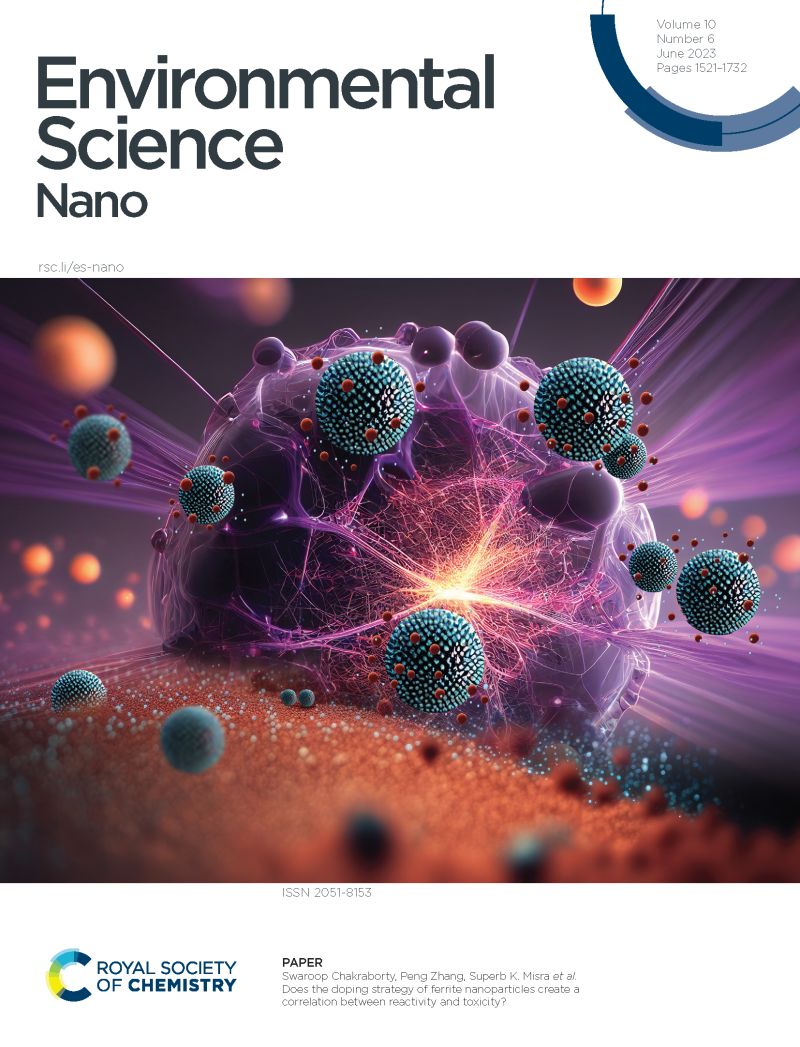Multi-omics analyses reveal the mechanisms of developmental toxicity of a covalent organic framework to the roots of rice (Oryza sativa) seedlings
IF 5.8
2区 环境科学与生态学
Q1 CHEMISTRY, MULTIDISCIPLINARY
引用次数: 0
Abstract
Covalent organic frameworks (COFs) are increasingly explored for applications in chemistry, medicine, and biology, yet their ecotoxicological profiles remain poorly defined. In this study, we assessed the developmental toxicity of ethidium bromide-based covalent organic frameworks (EB-COFs) in rice (Oryza sativa) seedlings in hydroponic culture. Seedlings were exposed to EB-COFs at concentrations ranging from 0.1 to 1000 mg L−1 for 14 days. Shoot length, fresh weight, total chlorophyll content, and photosynthetic rate were unaffected at 100 to 1000 mg L−1; however, root length was significantly inhibited, particularly at 1000 mg L−1, where oxidative damage was observed in roots. To elucidate underlying mechanisms, we performed transcriptomic and metabolomic profiling on roots exposed to 1000 mg L−1 EB-COFs. Differentially expressed genes (DEGs) involved in development and stress responses, for example, WRKY24, were found to be upregulated. Metabolomic profiling identified 1190 differentially accumulated metabolites (DAMs), including key compounds involved in oxidative stress response and root development such as ferulic acid and p-coumaric acid. Pathway enrichment analysis revealed that EB-COFs primarily affected phenylpropanoid biosynthesis, glutathione metabolism, and tryptophan metabolism, which are critical for root growth and stress defense. Our study provides the first comprehensive demonstration that EB-COFs selectively impair rice root growth by inducing oxidative stress and perturbing key metabolic and signaling pathways. These results suggest that future environmental safety assessments of COF materials should include their potential impact on plant health, particularly focusing on oxidative stress and root development.

多组学分析揭示了共价有机框架对水稻幼苗根系的发育毒性机制
共价有机框架(COFs)在化学、医学和生物学领域的应用越来越广泛,但其生态毒理学特征仍不明确。在本研究中,我们评估了溴化乙啶基共价有机骨架(EB-COFs)在水培水稻(Oryza sativa)幼苗中的发育毒性。将幼苗暴露于浓度为0.1至1000 mg L−1的EB-COFs中14天。100 ~ 1000 mg L−1处理对茎长、鲜重、叶绿素总含量和光合速率无影响;然而,根长明显受到抑制,特别是在1000 mg L−1时,根中观察到氧化损伤。为了阐明潜在的机制,我们对暴露于1000 mg L−1 EB-COFs的根进行了转录组学和代谢组学分析。参与发育和应激反应的差异表达基因(deg),如WRKY24,被发现上调。代谢组学分析鉴定出1190种差异积累代谢物(DAMs),包括参与氧化应激反应和根发育的关键化合物,如阿魏酸和对香豆酸。途径富集分析表明,EB-COFs主要影响苯丙素生物合成、谷胱甘肽代谢和色氨酸代谢,这些对根系生长和逆境防御至关重要。我们的研究首次全面证明了EB-COFs通过诱导氧化应激和干扰关键的代谢和信号通路,选择性地损害水稻根系生长。这些结果表明,未来COF材料的环境安全评估应包括其对植物健康的潜在影响,特别是关注氧化胁迫和根系发育。
本文章由计算机程序翻译,如有差异,请以英文原文为准。
求助全文
约1分钟内获得全文
求助全文
来源期刊

Environmental Science: Nano
CHEMISTRY, MULTIDISCIPLINARY-ENVIRONMENTAL SCIENCES
CiteScore
12.20
自引率
5.50%
发文量
290
审稿时长
2.1 months
期刊介绍:
Environmental Science: Nano serves as a comprehensive and high-impact peer-reviewed source of information on the design and demonstration of engineered nanomaterials for environment-based applications. It also covers the interactions between engineered, natural, and incidental nanomaterials with biological and environmental systems. This scope includes, but is not limited to, the following topic areas:
Novel nanomaterial-based applications for water, air, soil, food, and energy sustainability
Nanomaterial interactions with biological systems and nanotoxicology
Environmental fate, reactivity, and transformations of nanoscale materials
Nanoscale processes in the environment
Sustainable nanotechnology including rational nanomaterial design, life cycle assessment, risk/benefit analysis
 求助内容:
求助内容: 应助结果提醒方式:
应助结果提醒方式:


